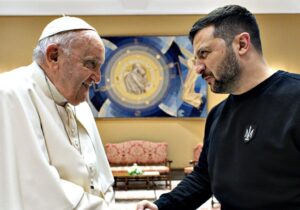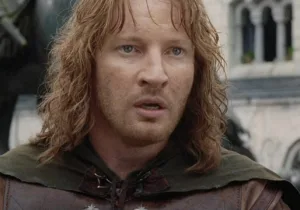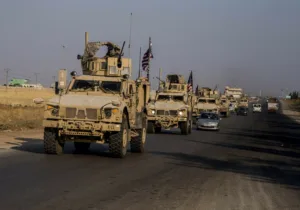This essay appears in our current print edition, winter 2016. Continue below for text-only or enjoy the (eye-catchingly lovely) PDF print final. If you like what you see, we invite you to subscribe. To do so, simply click the link to the upper right.
—
The Dawn of Mars
In the dead of night, young Caspian, future King of Narnia, stands with his tutor Cornelius atop the central tower in the great castle at the center of the realm. They have come to witness the conjunction of two noble planets. Tarva, the Lord of Victory and Alambil, the Lady of Peace, will pass within one degree of each other. Such a meeting, Cornelius instructs his pupil, has not happened for two hundred years, and signals fortune for the sad land; which, we soon learn, manifests in Caspian’s commanding an insurrection of dwarves and talking beasts in The Great War of Deliverance that liberates Narnia from the usurping grip of his evil Uncle Miraz.
By some accounts, all of this is a bit too much. Phillip Pullman, the author of the His Dark Materials trilogy, asserted that the Narnian Chronicles “is one of the most ugly and poisonous things I’ve ever read…[it demonstrates]…a sado-masochistic relish for violence.” Quite similarly, a pair of literary critics charged that among the books’ offenses are the “glorification of conflict and retribution” and the “legitimizing of cruelty.” They might well have had Prince Caspian particularly in view: blood, battle, betrayal, maiming, and death feature frequently. Indeed, the High King Peter, just a schoolboy, is described as having felled one enemy by “slash[ing] his legs from under him and with the back-cut of the same stroke, wallop[ing] off his head.” It’s grim, to be sure. But to Pullman it’s much more: “The highest virtue – we have this on the authority of New Testament itself – is love, and yet you find not a trace of that in the [Narnia] books.”
Heartened as I’m sure Lewis would be by his atheist critic’s pontificating on the character of the Christian bible, Pullman doesn’t have it quite right – love, that is. For Lewis, the Narnian stories are all about love – not about love despite the battles and wars, but about love that, because it is love, reveals itself in war and, most crucially, in the character of the warriors who wage them. But let us begin in another place.
In Lewis’ Oxford rooms, there hung a facsimile of Venus and Mars by renaissance master Sandro Botticelli. The painting portrays the post-coital deities reclining opposite one another in a little wood and surrounded by frolicsome satyrs. The work is typically taken to symbolize the platitude that love conquers war, and the immediate presentation seems to bear this out: Venus, goddess of love, is clothed and awake, watching Mars, the war god, naked and very much asleep, unarmed and unarmored – captive perhaps by the Venerian fetters of la petite mort.
However, initial appearances aside, this interpretation cannot be. Lewis was self-confessedly unenthusiastic about paintings in general, as the mostly unadorned walls in his office and home might testify, and it cannot be believed that he, hardly one to go in for simplistic aphorisms, would make an exception for one so garishly sentimental. Instead, we should look to a letter he wrote to a friend in which he mused, “In a certain juncture of the planets, each planet may play the others’ part.” Turning back to Botticelli, this suggestion has some purchase. Mars has lost much of the martial aspect. Dispossessed of his armor and his lance –- euphemistically unmanned – he is defenseless as he slumbers almost fully exposed. Venus, however, appears to have taken up the martial character. She may not be merely watching Mars but watching over him as well: she has acquired her lover’s helm and lance, which thanks to the satyrs have now been visually repositioned so as to suggest she is wielding them. Truly, each does seem to play the other’s part.
But, importantly, the reversal is incomplete. Venus is still Venus – her continued physical beauty is delicately eroticized by her diaphanous gown, which not only teasingly hints at the comely form beneath but which she happens to be presently drawing up her leg – one can see the folds of garment just beginning to gather beneath her fingers as she pulls. Precisely what she has in mind might be suggested by the satyr who appears about to wake Mars with a conch shell blast in his ear. Mars, for his part, is still recognizably the war god: well-muscled, his strength remains at hand, however immediately latent – indeed, his very nakedness, while at one level suggesting vulnerability, was in the Renaissance imagination a sign that he was in total control even when most vulnerable.
Accounting for this resilient self-possession, Lewis described how Renaissance depictions of inverted relationships in images of cosmic order were meant to convey mutual reconciliation, if not détente, rather than a triumph of one over the other. This idea is borne out in the name of Venus and Mars’ most noteworthy offspring, their daughter Concordia – the personification of harmony. Venus and Mars – love and war – embrace and reform one another in mutual self-giving without either annihilating the other. Now this idea is something with which Lewis could truck.
It also alerts us to what Lewis might have been up to on that central tower in Narnia. While it is popularly assumed that Tarva and Alambil signify the Narnian version of Mars and Venus, this might not be so. In Planet Narnia: The Seven Heavens in the Imagination of C.S. Lewis, Michael Ward points out that on several occasions we are told the Narnian morning star is actually called Aravir, not Alambil. Instead, Ward posits, the conjunction that Caspian observes is meant to be the coming together of two aspects of the Martial influence. “Mars is not only a fighting-machine,” Ward notes, “he has a more pacific, life-giving dimension too.” Mars was originally a spring-time god of vegetation and fertility. Under the name Mars Silvanus, his functions were rustic; he dwelled in forests and mountains and cared for cattle. His warrior dimensions, Mars Gradivus, came later, eventually superseding his less-belligerent roles. This double-nature is paralleled both in the Botticelli – by the presence of arms and armor as well as woodland satyrs and the lover’s arboreal nest – and in the architecture of the Narnian tower itself – which Lewis describes as having battlements on one side and on the other, un-embattled side, a direct view of the castle gardens.
In any case, whether through the influence of Venus or the two-aspects of his internal character, Lewis’ Mars – and the martial character he influences in others – is about much more than war and violence. For Lewis, the fullness of the martial character is best communicated by the chivalric idea of “the knight – the Christian in arms for the defence of a good cause”; which Lewis called “one of the great Christian ideas.” This chivalric ideal, in turn, is best understood through those words addressed to the dead Launcelot, the greatest of all the knights, in Malory’s Morte D’Arthur: ‘Thou wert the meekest man that ever ate in hall among ladies; and thou wert the sternest knight to thy mortal foe.’ Lewis expounds:
The important thing about this ideal is…the double-demand it makes on human nature. The knight is a man of blood and iron, a man familiar with the sight of smashed faces and the ragged stumps of lopped-off limbs; he is also a demure, almost a maidenlike guest in hall, a gentle, modest, unobtrusive man. He is not a compromise or happy mean between ferocity and meekness; he is fierce to the nth and meek to the nth.
We find presupposed in this what the late political theorist – and Narnia-friend – Jean Bethke Elshtain found presupposed in the just war tradition – that is, “a ‘self’ of a certain kind…one strong enough to resist the lure of seductive, violent enthusiasms; [and] one bounded by and laced through with a sense of responsibility and accountability.” This is because chivalry was always something more than literary artifact.
Writing at the beginning of the Second World War, Lewis found the chivalric ideal to be terribly relevant: “It may or may not be practicable – the Middle Ages notoriously failed to obey it – but it is certainly practical; practical as the fact that men in a desert must find water or die.” The key was in remembering the knight “is a work not of nature but of art; of that art which has human beings, instead of canvas or marble, for its medium.” Chivalry attempted to bring together two things that since the fall of humanity have no natural tendency to gravitate toward one another: it teaches “humility and forbearance to the great warrior because everyone knew by experience how much he usually needed the lesson” and it demands “valor of the urbane and modest man because everyone knew that he was as likely as not to be a milksop.”
The danger, as Lewis saw it, was that if we cannot produce Launcelots, humanity falls into two sections — those who can deal in blood and iron but…know nothing about mercy and kill men as they cry for quarter, and “those who are ‘meek in hall’ but useless in battle.”
What’s Love Got to Do with It?
It is probably time for a philological refresher. The term “meek” is rather out-of-favor nowadays. ‘Meek’ sounds ‘weak’, hardly a quality worth cultivating. Jesus of course paints a similarly perplexing image when he assures us that the meek are especially blessed. But there is nothing ‘weak’ or ‘spineless’ about the meek. Indeed, the term from which both the chivalric ideal and scripture draws is praus, a term used to describe a warhorse trained for battle – emphasizing power disciplined, or ferocity under restraint. War horses could propel their 2,000 pounds up to 35 miles-per-hour, smashing through and scattering enemy formations; they could instantly respond, in the din of battle, to the sudden commands of the one who held their reins; and they could bite and kick and strike and become, themselves, deadly weapons. There was nothing ‘weak’ about them. In this sense, ‘meek’ is the best summary-word for the way in which love qualifies (but does not abolish) the martial spirit and its lethal expression.
But why does love not abolish the martial spirit? How can love and war ever, really, be compatible? While it is obvious how war can be waged out of love in defense of one’s threatened neighbor, it remains that the one who is doing the threatening is a neighbor as well. How can we both love our enemy-neighbor and kill him?
In The Problem of Pain, Lewis avers that when people think about love they very often confuse it with kindness – the “desire to see others…happy; not happy in this way or in that, but just happy.” However, Lewis insists:
Love is something more stern and splendid than mere kindness…There is kindness in Love but Love and kindness are not coterminous, and when kindness (in the sense given above) is separated from the other elements of Love, it involves a certain fundamental indifference to its object, and even something like contempt of it.
If these are harsh notions, they are also reasonable. Kindness does not concern itself so much with whether its object becomes good or bad, only that it escapes suffering. But love would rather see its object “suffer much than be happy in contemptible and estranging modes.” The warfighter, like the surgeon, knows that on occasion a hard thing has to be done to prevent the advent of an even harder thing. The surgeon also knows, as at least a just warfighter ought also to know, that the hard thing is not sometimes simply necessary but, very often, morally right – therefore morally obligatory. It is clear to medical professionals that they are not performing “lesser evils” but rather the greatest possible good. This should be equally clear to just warriors.
This is all, of course, a bit too glib. While the doctor can know with certainty that the festering, gangrened leg needs to be removed to heal the patient, to know without doubt that we are in the right on the battlefield is a claim to omniscience we cannot possess. This is all too complicated to address fully here, save to say two things.
First, there are times when it is quite clear where evil resides – one only need consider those men in the video collections kept by the ‘Saddam Special Treatment Department’ who used instruments to pry open mouths until jaws shattered; or sawed off limbs; or made a man stand by a wall with his head sandwiched between two wooden wedges to which his ears were nailed so that when he could no longer stand he slumped to the floor ripping them off; or raped women in front of their husbands; or who forced parents to watch their frantic children running naked around a closed cell containing an upturned hive, desperately trying to escape the cloud of stinging wasps. Love is consistent with the idea that “A deserves B for doing C”; and while the claim is not absolute, neither is it meaningless nor do we need to be, ourselves, the paragon of virtue in order to render just desserts.
Secondly, while the just war framework cannot claim omniscience it must embrace prudence. Acting in the world requires employing the wisdom one has – aided by reason, experience, and authority – and in then doing the best one knows with the limited information at hand. Of course, not to act is also a decision requiring some degree of justification.
Moreover, while it is a Christian duty to love both the victim and the victimizer, we obviously cannot love both in precisely the same way in the same instance. Love for one neighbor may manifest in his defense, love for the other in his correction. For Lewis, that the condemnation, punishment, and possible killing of an enemy can be an act of love can only be understood by remembering that as Christians we believe the human soul is eternal: “Therefore, what really matters is those little marks or twists on the central, inside part of the soul which are to turn it, in the long run, into a heavenly or a hellish creature.” In this, Lewis is fully aligned with both the just war and the chivalric tradition’s Thomistic hinterlands in which is asserted that though unchecked wrongdoing may well lead to the ‘happiness of sinners’, it is a false, macabre parody of happiness. Therefore, when restraining a wrongdoer by forcing him to stop, by deterring him from resuming, and ideally by provoking him to think again and change his aggressive ways, we work toward the promotion of the only possibility for his true flourishing. This belongs to his own good, even if it should cost him his very life.
However jarring that might be to current sensibilities, Lewis assures us, “that is what is meant in the Bible by loving [our enemy]: wishing his good, not feeling fond of him nor saying he is nice when he is not.” Of course, love is at work in our disposition toward these hard tasks and Lewis rightly insists, “Even while we kill we must try to feel about the enemy as we feel about ourselves – to wish he were not bad, to hope that he may, in this world or another, be cured: in fact, to wish his good.” This, too, is what we used to call love.
Last Thoughts
The Knight, Lewis insisted, that marbling together of what, in fallen humanity, are those contrasting dispositions – greatness and goodness, justice and love – found in the conjunction of Mars and Venus, is “the one hope in the world.” Such a union does not come easy in the best of times. In less optimum days, the task is all but impossible.
The sentiments found in Botticelli’s masterpiece are present there only because it was a product of a culture that still acknowledged her Greco-Roman and Judeo-Christian patrimony, an inheritance persistently disclaimed – we no longer believe in those foundations in which our best beliefs are anchored. As we abandon ourselves, the just war unity of Venus and Mars is increasingly divorced by those who dismiss the insertion of love into power politics “as a weak sentimentality” or, more prevalently, by those who regard “the combative side of man’s nature as a pure, atavistic evil”.
These same, tawdry alternatives of either “brutality or softness” were present in Lewis’ day as well. They were insufficient then. They are insufficient now. As Lewis warned: “The ideal embodied in Launcelot is…the only possible escape from a world divided between wolves who do not understand, and sheep who cannot defend, the things which make life desirable.” In a world facing such threats as the prospect of a nuclear Iran, the march of ISIS beyond the Levant, and a despot in Russia, Lewis’ closing comments in his reflection on the necessity of chivalry is ominous: “There was, to be sure, a rumour in the last century that wolves would gradually become extinct by some natural selection; but this seems to have been exaggerated.”
—
Marc LiVecche, Ph.D., University of Chicago, is the managing editor of Providence and Scholar on Christian Ethics, War, and Peace at the Institute on Religion and Democracy. This essay is drawn from a larger, book-length project provisionally titled, The Odious Necessity: C.S. Lewis on War. He twits…tweets?…at @mlivecche
image: Venus and Mars, c. 1483. Tempera on panel. public domain







 Sponsor a student for Christianity & National Security 2024
Sponsor a student for Christianity & National Security 2024